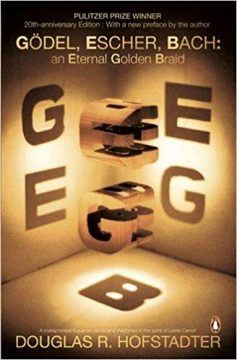Ilari Kaila in Aeon:
 Twenty years ago, in the preface to the 20th-anniversary edition of his classic book, Douglas Hofstadter marvelled at how misunderstood its thesis has been. A treatise on the nature of consciousness, it is often wildly misconstrued as an exploration of how ‘math, art, and music are really all the same’. But one likely source of the confusion is in the name – which is, at the same time, a big reason for the book’s lasting popularity: Gödel, Escher, Bach: An Eternal Golden Braid, or GEB for short, sounds like a promise of just such a dazzling, cosmic counterpoint. Another likely culprit is Hofstadter’s own musings about music. While M C Escher’s artwork elegantly (and literally) illustrates many of the book’s themes, Hofstadter’s attempts at justifying the inclusion of Bach are mostly banal and often badly off the mark.
Twenty years ago, in the preface to the 20th-anniversary edition of his classic book, Douglas Hofstadter marvelled at how misunderstood its thesis has been. A treatise on the nature of consciousness, it is often wildly misconstrued as an exploration of how ‘math, art, and music are really all the same’. But one likely source of the confusion is in the name – which is, at the same time, a big reason for the book’s lasting popularity: Gödel, Escher, Bach: An Eternal Golden Braid, or GEB for short, sounds like a promise of just such a dazzling, cosmic counterpoint. Another likely culprit is Hofstadter’s own musings about music. While M C Escher’s artwork elegantly (and literally) illustrates many of the book’s themes, Hofstadter’s attempts at justifying the inclusion of Bach are mostly banal and often badly off the mark.
There are good reasons for GEB’s fame besides the sexy and marketable title, though. In its attempt to build a grand theory of minds and meanings, the book discusses an eclectic range of topics and, at its best, does it in a genuinely enlightening way. It is obviously an inspired work, even if the fundamental case it sets out to make falls flat. Like most attempts at ‘explaining’ consciousness, GEB is rooted in a category mistake: it treats our phenomenological core as just another phenomenon, making the book an 800-page exercise in begging the question. But it’s a stimulating 800 pages, riffing on fractals, Zen koans, computer languages, quantum physics and much more.
More here.
